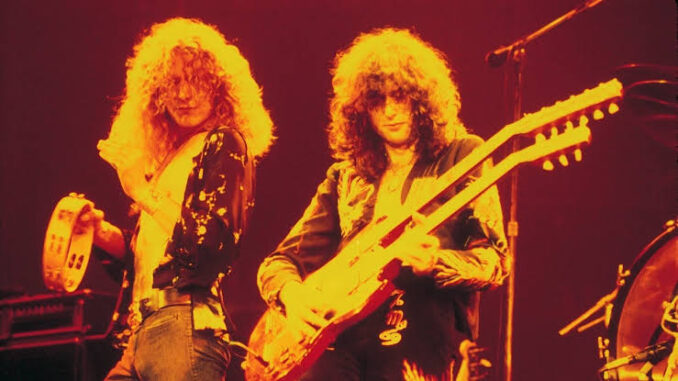
**Raw Power Revival: Led Zeppelin’s Iconic 1975 Performance of ‘In My Time of Dying’ at Earl’s Court Continues to Electrify Fans**
In the annals of rock history, few performances resonate with the same reverberating intensity as Led Zeppelin’s rendition of “In My Time of Dying” at Earl’s Court in 1975. This performance not only encapsulates the raw power of the band at its peak but also serves as a testament to the transformative nature of live music, where the interplay between artist and audience creates a momentary escape into the realm of pure exhilaration.
**The Context: A Decade of Dominance**
By the mid-1970s, Led Zeppelin was not merely a band; they had become a musical phenomenon. Following the release of their fifth studio album, “Physical Graffiti,” in early 1975, the band was riding high on a wave of commercial success and critical acclaim. This period was characterized by an artistic apex, as the band adeptly blurred the lines between rock, blues, and folk influences, culminating in a sound that was uniquely theirs.
Earl’s Court, with its cavernous space and capacity of over 18,000, served as the perfect setting for their legendary performances. The band performed six nights at the venue, cementing these concerts in the collective memory of music fans worldwide. Among the highlights of these shows was the chillingly powerful “In My Time of Dying,” a track that fully showcased Zeppelin’s musical prowess and theatrical flair.
**A Drenched in Emotion Performance**
The song, originally attributed to the Reverend Gary Davis, was reinterpreted by Zeppelin in a manner that transformed it into a harrowing rock odyssey. Clocking in at over eleven minutes, it was a thrilling journey through grief and redemption, centered around the themes of mortality and reflection. The 1975 performance stands out for its frenetic energy and the palpable emotional weight the song carries, largely thanks to Robert Plant’s haunting vocals and Jimmy Page’s searing guitar work.
What is most captivating about this particular performance is the way it evolves over its duration. Starting slowly, it builds up through a crescendo of sound engineered by John Bonham’s thunderous drumming and John Paul Jones’ intricate keyboard lines. Each musician feeds off the other, creating a sonic tapestry that pulls the audience along with them. Plant’s soulful wails intertwine with Page’s blistering guitar solos, while Bonham’s rhythmic prowess melds seamlessly with Jones’ harmonic subtleties.
The performance at Earl’s Court was laden with improvisation, a hallmark of Led Zeppelin shows. The band utilized this freedom to experiment, explore, and build tension before unleashing a blistering finale that left audiences gasping. Critics and fans alike often cite this free-spirited creativity as one of the reasons Led Zeppelin stands out amid their contemporaries.
**Enduring Legacy: Why ‘In My Time of Dying’ Still Resonates**
Decades later, the echoes of this performance continue to reverberate in the hearts of rock enthusiasts. The 1975 Earl’s Court concert not only solidified the song as a staple of the band’s live repertoire but also individual performances are frequently celebrated in retrospective discussions surrounding the power dynamics of live rock music.
Many in today’s music scene draw inspiration from Led Zeppelin’s willingness to stretch songs into sprawling arrangements, a practice that has found a resurgence in various sub-genres of rock and blues. Cover bands, tribute acts, and new artists alike delve into this material, offering fresh interpretations while invariably finding their roots in the raw power exhibited by Zeppelin at their high-water mark.
Additionally, the spectral quality of “In My Time of Dying” has garnered it the respect of modern musicians. The song’s exploration of existential themes resonates more in an age characterized by uncertainty and flux. Each note strikes a chord within listeners, rekindling memories and eliciting emotions that transcend time.
**In Conclusion: The Unfading Power of Rock**
As the rock genre continues to evolve, the significance of Led Zeppelin’s performance of “In My Time of Dying” at Earl’s Court in 1975 remains a touchstone for musical excellence. Their ability to transcend the typical concert experience and connect with audiences on a deeper emotional level is a legacy that lives on. The packed halls, the raucous cheers, and the breathless moments still ignite the imaginations of new generations, proving that, indeed, rock and roll will never die.
Leave a Reply